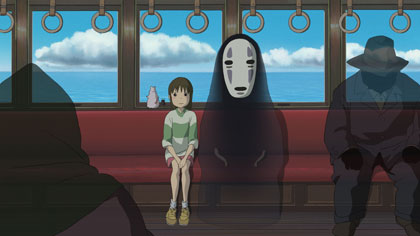
Gods and Monsters
Film of the Month: Spirited Away

Andrew Osmond salutes Spirited Away, a Japanese animation film that mixes fairytale surrealism with a belief in empowerment through labour
Spirited Away (Sen To Chihiro No Kamikakushi), a Japanese animated fantasy about a little girl's adventures in a realm of gods and monsters, invites comparisons to the Alice books, The Wizard of Oz and even Harry Potter. First and foremost, though, this remarkable film is embedded in the personal universe of its auteur-director Hayao Miyazaki, whose standing in Japan is comparable to Steven Spielberg's or, indeed, J.K. Rowling's in the west. From its opening in 2001, Spirited Away has become the biggest Japanese release in history. It is also the most successful 'foreign' film ever made, with the bulk of its revenue earned in its native country. The film shared the Golden Bear at last year's Berlin festival, followed by an Oscar for best animated feature. It is released in Britain both dubbed and subtitled, the dub produced by Disney and directed by Kirk Wise, who co-directed Beauty and the Beast and Atlantis The Lost Empire.
It's the baggage Spirited Away carries as a Miyazaki film that may bewilder British audiences. The director's previous film, the medieval fantasy Princess Mononoke (1997), is available on UK video, but to steal a phrase often applied to Woody Allen, both it and Spirited Away depart from Miyazaki's early, funny pictures. Not that Spirited Away is humourless it has some splendid gags but it's deeply recursive, uniting themes and images from across the director's past work. To take the most obvious example, the soot-sprites that toil in the boiler room of the spider-man Kamaji here appear in a different role in Miyazaki's My Neighbour Totoro (1988), while many other elements form part of what might be called Miyazaki-land: his fascination with flight, ecology, elaborate buildings, strong girls, weary gods, overbuilt machinery, empowering labour, even the pigs heroine Chihiro's gluttonous parents turn into. Spirited Away is not a sequel or spin-off, yet it's part of a one-man brand some western critics gloss as that exoticising standby, inscrutable orientalism.
Then again, the film's opening demonstrates the cross-cultural universality of fairy tales. A family wanders, or is lured, into a magic place where the parents eat tempting food and turn into pigs. Miyazaki cites Japanese folk tales as his influence here, but one could equally invoke Hansel and Gretel or Circe in Homer's Odyssey (a work referenced by Miyazaki in the past). The first minutes slide from normality to unease to menace as Chihiro's unwitting parents poke round what they think is a theme-park recreation of old Japan. The crescendo climaxes as the sun sets, the lanterns glow, and Chihiro finds her parents grotesquely transformed. She's not just scared, she's revolted, grossed-out; her body wriggles with nausea before she breaks and runs. The scene evokes the darker moments of classic Disney but with more edge than Walt's balletically styled terrors. Then with barely a pause the mood switches as the heroic boy Haku takes charge, pulling the hapless girl on a dizzy dash to a bathhouse patronised by gods and spirits (where most of the film is set). The delicacy of the score by Joe Hisaishi (a regular musician for live-action director Kitano Takeshi) gives way to bolder strokes la John Williams, announcing a transition to high adventure.
From here on the audience is at Chihiro's eye-level, to sink or swim in a fantasy world somewhere between Wonderland and Harry Potter's Hogwarts, less soap-bubble surreal than the first, more quirkily digressive than the second. Here a spider-man works beside walking frogs and soot-balls with eyes, but there are also boilers, elevators, even an amphibious train. The bathhouse is furnished in lavish mosaic detail, from the painted partitions to the patterns on the cushions. No doubt this reflects the director's expressed desire to do justice to Japan's design heritage the bathhouse blends architecture from various periods ? but then Miyazaki has always been a craftsman of imagined space, creating eminently explorable, 'solid' drawn worlds that owe little to Spirited Away's fairly sparse CG effects. Miyazaki's worldbuilding has been compared to that of some videogame adventures, which also depend on first-person exploration, but analogies are legion, from the baroque-gothic labyrinths of Mervyn Peake's Gormenghast to the play-worlds of Rupert the Bear.
Initially Chihiro stumbles through her world, hurtling down steep stairs and being magically yanked across hallways. Her switch to active protagonist is signalled in the second half, when she hitches up her worker's uniform, runs along a treacherous metal pipe that nearly drops her to her doom, then climbs the bathhouse to the top. What causes this change? Miyazaki's answer is hard work, but of a different order from the jovial capitalism of Disney's dwarves. One of the director's most popular earlier films, Kiki's Delivery Service (1989), was about a teen witch making flying deliveries while coping with adolescence. Spirited Away has a similarly offbeat work regime with Chihiro tending Japanese gods and learning responsibility and purpose. This has less to do with stereotypes of the industrious Japanese than with Miyazaki's own leftist leanings and belief in empowerment through labour. What makes it more than dreary moralism are the witty riffs on the theme. Chihiro's first trial is to help a soot-sprite carry unnaturally heavy lumps of coal; she succeeds, only for all its co-workers to drop their burdens before her en masse.
Later the bathhouse manager Yubaba (a huge-headed matriarch seemingly modelled on the Duchess in Tenniel's Alice illustrations) tries to steal Chihiro's name and identity. However, instead of depicting the girl's new job as dehumanised drudgery, Miyazaki turns it into a heroic, Herculean struggle. As Chihiro strives to clean a stinking gloop-god, stumbling, banging her head, trudging through faecal slime, there's a palpable sense of the once weak girl building an identity through toil, redefining the labour as her own. Eventually the bathhouse inmates rally to help her in a multi-species display of worker unity, but it's she who stands alone at the end as the revealed deity intones a transcendent "Well done". Meanwhile Yubaba's doppelganger Zeniba lives in a thatched farmhouse pursuing handicrafts, while Yubaba's giant baby, now a mouse, becomes a comic proponent of unalienated labour.
At the farmhouse Zeniba gives the characters an Alice-style tea party, which fits with the film's recurring images of eating, cleansing and purging. These range from the sublime (a storm that leaves the bathhouse surrounded by sea) to the outrageous (the monstrous No-face burying Yubaba in a diarrhoea-like avalanche of vomit). A passing mention of Japan's 'bubble' economy, with its associations of national indulgence, foreshadows the gluttony of No-face and Chihiro's parents, not to mention the great baby ensconced among painted mountains and palaces, refusing to go out for fear of "bad germs". Thematically, this marshalling of motifs and images is sound; more contentious is the film's narrative structure, which introduces new characters and strands half way through while leaving Chihiro's parents almost forgotten in the mix. It's an eccentricity that may not have been fully intended by Miyazaki, who reportedly altered his story outline in mid-production. Yet it makes aesthetic sense why shouldn't Chihiro's adventures wrongfoot the audience? The unpredictability can be wearing but also bracing, an antidote to the pat rollercoaster climaxes of such animations as Monsters, Inc.
Disney's dub (featuring Lilo voice-actress Daveigh Chase as Chihiro) is a creditable effort, though it lacks the spontaneity of original animation soundtracks and some of the 'extra' voices are weak. Western audiences may chafe at the sub-Disney frame rate (much of the animation is done on 'threes', or eight distinct frames a second) and the cartoon acting can't match that of the best US studios. That said, Chihiro's fearful, clinging behaviour is well observed, while her character design with a thin gawky body and pipe-cleaner legs is inspired. In any case, cartoon acting was never the sine qua non of Miyazaki's films, which are built instead on heightened situations and sublime fantasy landscapes. Even if CG cartoons come to dominate Japan as they do much of the world, there's a corner of the animation field that will be forever Miyazaki.
